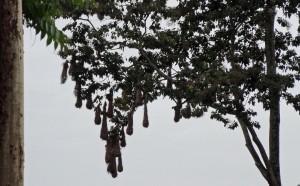This morning several of us got up to watch the sun rise over the beach at Tortuguero. Days in Costa Rica are not much longer or shorter than 12 hours because it is so close to the equator. Perhaps because of cloud cover, we also didn’t get the see the sun rise in an orange ball of fire the way it does at home. It just started to get light, and was daylight within about 10 minutes.
Before breakfast we did a wildlife tour by boat through the rivers and canals of Tortuguero. The waterways snake around in all directions. They are called canals, which made me think they were dug out by people, but they are all natural. We saw several monkeys in trees, a sloth at the very top of a huge tree, lots of birds, several iguanas and lizards sunning themselves, and a caiman near a Canadian research station that we happened across.
The highlight was running across a group of capuchin monkeys getting into several buckets of food waste that someone had left out on a dock to be picked up. They were having a field day, having lucked into free food supply. I got 3 minutes of great video of the monkeys getting in and out of the food. Another highlight was boating back into a branch of the river and watching the water turn black from the tannin in the trees. The black water reflected the image of the trees on the shore — even the depth seemed to reflect so that it looked like the trees were growing down into the river.
One of the most interesting and ubiquitous birds we have seen — and heard — is the oropendola. They build nests like I’ve never seen in the U.S. — the nests are in bulbous formations that hang from tree branches. They also sound like nothing I’ve ever heard before. The name “oro” or gold refers to the birds’ yellow plumage, and “pendola” refers to the hanging nests. I won’t forget those birds anytime soon!
Later walking around in the town of Guapiles, our resident director Paul pointed me to passion fruit, which I’ve never had before. It doesn’t look like much on the outside, but the inside is something special. It looks like caviar and tastes sweet but not sugary. Hopefully I can find this fruit at the Whole Foods in Columbus because I can’t bring back the bunch that I bought here, and I definitely want to eat this again.
In the evening it was back to Earth University.





